Before constructing any structure on the soil, we make the base stable and strong so that it does not settle in large amounts with time. This process of making the soil base solid before the construction of structure is called Compaction.
Compaction is usually done with heavy machinery and equipments.

With time we have learned that if we add little water to the soil and then try compacting it, it gets better compacted. Because water acts as lubricating agent and when the load is applied to the soil, it helps soil particles move more easily and helps soil achieve denser configuration.
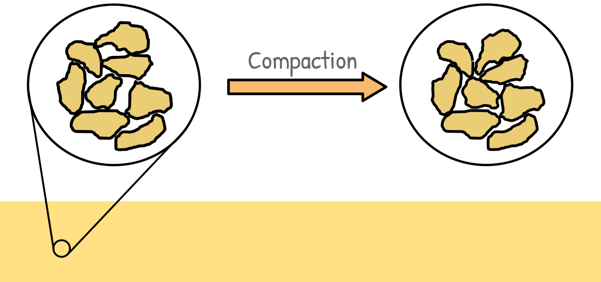
We have discussed compaction in detail in our previous post.
Compaction is measured by Dry Density of Soil. Higher the dry density, higher is the compaction.
Dry density of Soil is nothing but density of soil when it is in completely dry state which means no water is present in its pores. So the Dry Density of soil is mass of soil solids only divided by its volume.
To assess the level of compaction in any soil we perform laboratory and field test it. One such laboratory test we recently discussed in our previous post is Standard Proctor Test.
In such tests soil is compacted with different amount of water contents in it and respective Dry Densities obtained are recorded. The obtained data is plotted in a curve that is known as Compaction Curve. In curve we observe the dry density of soil increases with the increase in water content till a maximum value is reached. It happens because water acts as a lubricating agent and helps particles move more easily to achieve denser configuration.

Then if we keep on adding the water to the soil, the dry density begins to decrease. Because now water begins to occupy the space that otherwise might have been occupied by the soil particles.
With the curve we try to find out the water content at which the soil is most dense or most compacted. Then we add that amount of water in the soil and compact it in the field.
Soil is a mixture of different mineral particles of different sizes. It is characterised by the size of its particles. It is called sand if the size of the particles range from 75 micron to 4.75 mm. It is silt if particle size is between 2 micron to 75 micron. And it is clay if size is less than 2 micron.

Usually silt and clay minerals are different than sand minerals and because of these minerals these fine soils exhibits a property called plasticity.
 Plasticity is the property of soil that allows it to undergo deformation without cracking or breaking. These soils can be moulded into different shapes when water is added and can retain that shape when dried.
Plasticity is the property of soil that allows it to undergo deformation without cracking or breaking. These soils can be moulded into different shapes when water is added and can retain that shape when dried.
The kind of compaction curve, the typical inverted V shape, is obtained when soils contain at least some amount of cohesive soils that possess plasticity.
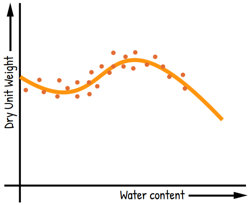 But when we obtain the compaction curve for pure sandy soils, the trend is somewhat different.
But when we obtain the compaction curve for pure sandy soils, the trend is somewhat different.
There is large scattering of the points on the compaction curve. The effect of water content on the dry density of pure sandy soils is not well defined. In sandy soils the dry density initially decreases with increase in the water content, which is opposite to what we observed in other soils.
By Dry Density formula,

we can see we are keeping the soil solids constant through out the experiment, but Dry Density or Dry Unit Weight is decreasing with the increase in water content. That means, volume of soil must be increasing to keep the equation correct. This increase in the volume of sand due to increase in moisture content is known as Bulking of Sand.
Bulking of Sand
When dry sand comes in contact with water, the water or moisture forms thin films around the sand grains. This creates capillary tension which keeps the water in between the soil particles and resists them to come close to each other. Hence the volume of soil increases which results in an expansion or swelling of the sand mass. Which is called Bulking of sand.
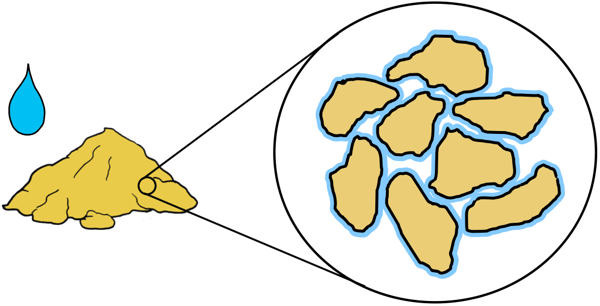
The maximum bulking occurs at a water content of about 4 to 8 per cent and the increase in volume of sand may range from 20 to 40 percent.
We calculate water content in any soil as weight of water present in the soil divided by weight of soil solids only.
When the moisture content is increased further, by adding more water, beyond 8-10 percent, the bulking of sand effect almost disappears. It happens because the excess water destroys the capillary meniscus and the particles can now come closer. Hence soil’s volume begins decreasing.

In the compaction curve of sand as the water content is increased, the water forms thin films around the sand grains and resists them to take a denser state. 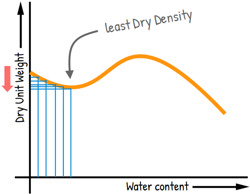 Hence the volume of soil increases and dry density, which is mass by volume, begins decreasing.
Hence the volume of soil increases and dry density, which is mass by volume, begins decreasing.
When we keep on increasing the water content sand reaches a point where it shows the effect of bulking most and dry density is least.
When the moisture content is increased further the bulking of sand effect disappears and sand particles pack densely. Hence it’s volume decreases and the dry density begins to increase.
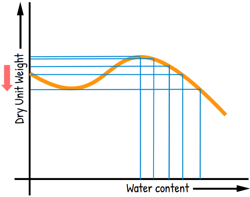 Again the Dry density of sand keeps on increasing until sand becomes fully saturated.
Again the Dry density of sand keeps on increasing until sand becomes fully saturated.
If the water content is increased beyond this point, the Dry Density again decreases. Because water that fills the voids in the sand, now applies a pressure called pore water pressure, on soil particles and pushes them away. Which again increases the volume of sand and hence Dry Density decreases.
Behaviour of these pure sandy soils is different upon compaction from that of soils containing some amount of finer cohesive particles because
1. Sand grains are more rounded compared to the plate like structure of finer-grained or cohesive soil particles.
2. sand grains are electrically neutral while cohesive particles carry electrostatic charge

For sandy soils, the compaction curve is of little practical use in compaction. Therefore for sandy soils, instead of Dry Density, the Relative Density is used as a criterion for measurement of compactness or denseness.
Relative Density has been discussed in detail in our earlier post. Relative density which is also called Density Index, can be understood as the ratio of the soil’s current compactness by its maximum compaction. It ranges from 0 to 100%. higher values indicate a more densely compacted soil, and smaller values represent loose soil. It is mathematically defined as this.

e is the void ratio of the soil
emax is the maximum void ratio
emin is the minimum void ratio
This bulking of sand is dependent on two factors:
1. The fineness of sand particles
Fine sands, that is sand particles of size on close to 75 micron, show higher bulking as compared to the coarse sands.
2. Percentage moisture content present
We have already seen how water content affects the volume of sand.
Well sand is not only used in foundations, it is a construction material and is also used in making things like mortar, plaster and concrete.
And if we forget to consider this bulking of sand effect we may mis calculate material quantities required for concrete mix designs. Hence the strength and durability of the structure we are building may be severely affected.
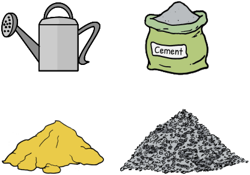 For example if we create a concrete mix and adopt batching by volume method. Batching by volume means materials used are measured by volume rather than by weight. Then while creating such concrete mix if we don’t consider the bulking of sand effect, the amount of sand will be taken less than required. And our concrete mix will be disproportionate and non-uniform. Such a concrete mix is more prone to cracking, settling, and overall structural failure, posing risks to the safety and longevity of the construction. Also the additional moisture present in the sand can reduce the strength of concrete.
For example if we create a concrete mix and adopt batching by volume method. Batching by volume means materials used are measured by volume rather than by weight. Then while creating such concrete mix if we don’t consider the bulking of sand effect, the amount of sand will be taken less than required. And our concrete mix will be disproportionate and non-uniform. Such a concrete mix is more prone to cracking, settling, and overall structural failure, posing risks to the safety and longevity of the construction. Also the additional moisture present in the sand can reduce the strength of concrete.
So, to mitigate the bulking effect of sand, during the concrete mix preparation, the volume of sand is adjusted by increasing it to a specific percentage in the mix.
Bulking test on fine aggregates has to be performed before using it in construction.






